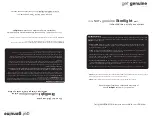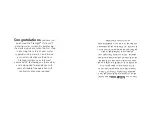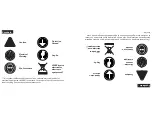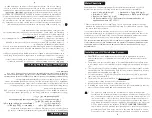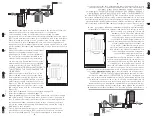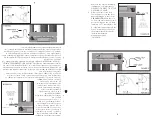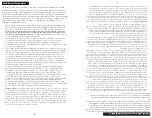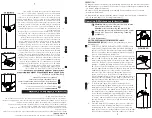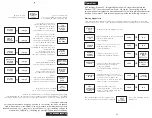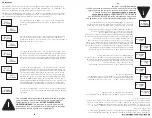
Water Chemistry:
Water quality is extremely important for the optimum performance of your UV
disinfection system. The following levels are recommended for installation:
• Iron: < 0.3 ppm (0.3 mg/L)
• Hardness*: < 7 gpg (120 mg/L)
• Turbidity: < 1 NTU
• Manganese: < 0.05 ppm (0.05 mg/L)
• Tannins: < 0.1 ppm (0.1 mg/L)
• UV Transmittance: > 75% (call factory for recommendations on
applications where UVT < 75%)
* Where total hardness is less than 7 gpg, the UV unit should operate efficiently
provided the quartz sleeve is cleaned periodically. If total hardness exceeds 7 gpg,
the water should be softened.
If your water chemistry contains levels in excess of those mentioned above,
proper pre-treatment is recommended to correct these water problems prior to the
installation of your UV disinfection system. These water quality parameters can be
tested by your local dealer, or by most private analytical laboratories.
The parameters listed above are minimum and do not suggest a service free installation.
UV installations carry unique attributes thus it is possible to additional filtration may be
required to lower contaminant levels below the minimum requirements or to a non-
detectible level.
3
Installing your UV Disinfection System:
•
CAUTION
, electronic ballast must be connected to a grounded receptacle
and the lamp connector ground wire connected to the stainless steel reactor
chamber.
•
The disinfection system is designed to be installed at point-of-entry. Drip loops
in all cordage connected to ballast controller is highly recommended (see figure
1D).
•
The complete water system, including any pressure or hot water tanks, must be
sterilized before start up by flushing with chlorine (household bleach) to destroy
any residual contamination (see page 6).
•
For safety purposes, the disinfection system must be connected to a ground
fault circuit interrupt (GFCI).
•
The disinfection system is intended for
indoor use only, do not install disinfection
system where it may be exposed to the weather.
•
Install the disinfection system on cold water line only.
•
If treating the entire house, install the disinfection system immediately after the
water softener, if applicable and before any branch lines.
1. The picture on page 4 shows the installation of a typical drinking water
system and the related components that may be used for the installation. The
use of a by-pass assembly is recommended in case the system requires “off-
line” maintenance. If this is the case, it must be noted that the system will
require supplementary disinfection of the distribution system if any water is
used during this by-pass condition. In addition, during by-pass, the water will
NOT be disinfected and the attached
“DO NOT CONSUME THE WATER”
tag (included with this manual), should be physically installed on the by-pass
assembly until such time as the system is sanitized and returned to service.
Please refer to the complete disinfection procedure as outlined on page 6 of
Wat
er Chemistry:
Water qualit
y is extremely import
ant for the optimum perf
ormance of your UV
disinfection sy
stem. The f
ollowing le
vels are recommended f
or installation:
• Iron: < 0.3 ppm (0.3 mg/L)
• Hardness*: < 7 gpg (120 mg/L)
• Turbidity: < 1 N
TU
• Manganese: < 0.05 ppm (0.05 mg/L)
• Tannins: < 0.1 ppm (0.1 mg/L)
• UV
Transmit
tance: > 75% (call factory for recommendations on
applications where UVT < 75%)
* Where tot
al hardness is less than 7 gpg, the UV unit should operate ef
ficiently
provided the quartz slee
ve is cleaned periodically
. If total hardness e
xceeds 7 gpg
,
the water should be sof
tened.
If your w
ater chemistr
y contains le
vels in e
xcess of those mentioned abo
ve,
proper pre-treatment is recommended to correct these w
ater problems prior to the
installation of y
our UV disinfection sy
stem. These w
ater quality parameters can be
tested by y
our local dealer, or b
y most private analytical laboratories.
The parameters listed abo
ve are minimum and do not suggest a service free installation.
UV installations carry unique at
tributes thus it is possible to additional filtration may be
required to lower contaminant levels below the minimum requirements or to a non-
detectible level.
3
Installing your UV Disinf
ection Syst
em:
•
CAUTION
, electronic ballast must be connected to a grounded receptacle
and the lamp connector ground wire connected to the stainless steel reactor
chamber
.
•
The disinf
ection system is designed to be inst
alled at point-of-entry. Drip loops
in all cordage connected to ballast controller is highly recommended (see figure
1D).
•
The complete w
ater system, including an
y pressure or hot water t
anks, must be
sterilized bef
ore start up b
y flushing with chlorine (household bleac
h) to destroy
any residual cont
amination (see page 6).
•
For saf
ety purposes, the disinf
ection system must be connected to a ground
fault circuit inter
rupt (GFCI).
•
The disinf
ection system is intended f
or
indoor use only, do not inst
all disinfection
system where it ma
y be exposed to the w
eather.
•
Install the disinf
ection system on cold w
ater line only.
•
If treating the entire house, install the disinf
ection system immediately af
ter the
water sof
tener, if applicable and bef
ore any branc
h lines.
1 .
The pict
ure on page 4 shows the inst
allation of a typical drinking w
ater
system and the related components that ma
y be used for the inst
allation. The
use of a by-pass assembly is recommended in case the sy
stem requires “of
f-
line” maintenance. If this is the case, it must be noted that the sy
stem will
require supplementar
y disinfection of the distribution sy
stem if any w
ater is
used during this by-pass condition. In addition, during b
y-pass, the w
ater will
NOT be disinf
ected and the attac
hed
“DO NOT CONSUME
THE W
ATER”
tag (included with this manual), should be ph
ysically inst
alled on the by-pass
assembly until such time as the sy
stem is sanitized and ret
urned to service.
Please refer to the complete disinf
ection procedure as outlined on page 6
Summary of Contents for Sterilight PLATINUM SPV410-IHS22
Page 2: ......



